Scientists artificially refrigerated a salmon stream in Nova Scotia during last summer’s record heat wave. Hundreds of migratory and river-dwelling fish basked in the cold-water flows pumped into the river from a nearby groundwater well. The addition of cold water to the Wrights River was part of a Dalhousie University study conducted to determine if adding colder water to streams that become dangerously warm for trout and salmon during prolonged heat waves can help keep the fragile fish alive. Results, biologists say, were encouraging.
It’s no secret that coldwater-dependent fish like trout and salmon seek out thermal refuge when water gets too warm to comfortably survive. According to the study’s author, Kathryn Smith, a PhD candidate at the Centre for Water Resources at the university in Halifax, climate change is exacerbating the impacts that periods of hot weather have on coldwater rivers.
Nevertheless, questions remained about the likelihood of wild fish using a human-induced plume of cold water to seek thermal refuge. During a nasty July heatwave last summer, Smith and her colleagues got their answer.
Hundreds of fish ranging from Atlantic salmon and brown trout to white lake chub gathered amid the cooling flows of groundwater pumped into the river from a well adjacent to the Wrights River.
“We need to think about how we can adapt to that warming world and still preserve the Atlantic salmon [and other] coldwater biodiversity in our rivers,” Smith told Time Magazine last month. As the global climate continues to warm at record levels, it might be time for more active management of important coldwater rivers, biologists say.
The addition of well water was only part of the study. Dubbed the “active” portion of the experiment, the “passive” aspect of the effort involved diverting water from the river and passing it through an underground ditch. The river water cooled a few degrees as it passed through the subsurface ditch, and, similarly, fish gathered in the cooler water as it was piped back into the river.
Nevertheless, the active portion of the study seemed to bear better results, likely because the well water was much colder than the passively cooled river water. The groundwater was 9 degrees celsius (about 48 degrees Fahrenheit), compared to the water diverted through the ditch, which was just a few degrees cooler than the river when it was redirected to its source. While the ditch method wasn’t as immediately effective, this method may be more sustainable over longer periods of time, given that it utilizes surface water and not water that has to be pumped into the river.
Salmon and trout tolerate water in the high 60s and, in the case of Atlantic salmon, even into the low 70s for short periods of time. But prolonged exposure to warm water can make fish sluggish and more susceptible to injury when they’re caught by anglers and released. Long-term exposure to warm water will eventually kill the fish.
That’s why both trout and salmon, during periods when water temperatures increase to less-than-ideal levels, seek out spring seeps and cooler inflows from smaller tributary streams. These thermal refuges are vital to the long-term survival of coldwater fish.
“These refuges are known to promote resilient and diverse aquatic ecosystems that can withstand both short-term heat waves and potentially long-term climate warming, but thermal refuges are not distributed uniformly in space,” the study’s abstract reads. “Thus, proactive human alterations, such as engineered thermal habitat creation or restoration, is an emerging research topic in [in eastern Canada and other locations where Atlantic salmon are indigenous] at the latitudinal or altitudinal limit of cold-water fish distribution.”
During the study, the plume of cold well water extended some 60 meters downstream and likely helped save fish that used it to escape hot water in the river that, in some stretches, climbed to 30 degrees celsius (about 86 degrees Fahrenheit!).
“It was exhilarating,” Smith told Time when the scientists documented the fish using the plume to escape the heat from the river. “[There was] lots of hooting and hollering from excitement.”




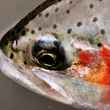






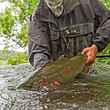





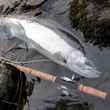








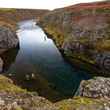
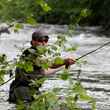


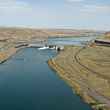
Comments
Gordon Woodward replied on Permalink
This story is a pretty wild idea, but I always was wondering if they could put solar panels next to the river to cool down the river????
Kasey replied on Permalink
I wonder if they’ve considered running the river water through a ground source heat pump and returning it to the river instead of extracting water from the ground. Then you’d be taking heated water from the river and exchanging it with cool water increasing the impact of the cool water. A bit more sustainable than water extraction as well since ground water resources are limited and often overused.
Richard replied on Permalink
How did these fish survive in the past when warming eras were even warmer?
Pages